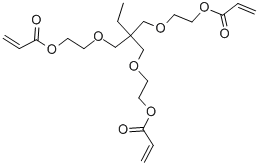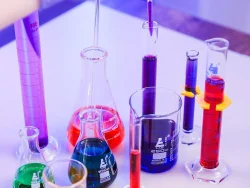Trimethylolpropane triacrylate
Synonym(s):TMPTA
- CAS NO.:15625-89-5
- Empirical Formula: C15H20O6
- Molecular Weight: 296.32
- MDL number: MFCD00008628
- EINECS: 239-701-3
- SAFETY DATA SHEET (SDS)
- Update Date: 2025-12-26 08:49:36

What is Trimethylolpropane triacrylate?
Description
Trimethylolpropane triacrylate (TMPTA) is a multifunctional acrylie monomer. It reacts with propyleneimine to form polyfunctional aziridine. Sensitization was observed in a textile fabric printer. Patch tests were positive with the polyfunctional aziridine hardener, but were negative to TMPTA. TMPTA caused contact dermatitis in an optic-fiber manufacturing worker and was reported as a sensitizer in a floor top coat or in photopolymerizable inks.
Chemical properties
Colorless viscid liquid
The Uses of Trimethylolpropane triacrylate
Trimethylolpropane triacrylate has important properties like low volatility, resistance against weather, chemical, water and abrasion, and immediate curing property. The above mentioned properties prompted its use in the production of adhesives, plastics, sealant chemicals, paint additives, photosensitive chemicals, ink and toner. It finds application in alkyd coatings, dental polymers, compact discs, hardwood floors, concrete polymers, screen printing, elastomers, automobile headlamps, acrylics and plastic components for the medical industry.
The Uses of Trimethylolpropane triacrylate
Trimethylol propane triacrylate is a triacrylate for use in UV -curable lithographic inks, varnishes, artificial nails, wood finish solder, and etch resists in the electronics industry.
Preparation
Synthesis of trimethylolpropane triacrylate: 2.44 kg of trimethylolpropane, 3.93 kg of acrylic acid, 0.5 kg of an acid ion exchanger (Lewatit 3333 of BAYER AG), 9 g of hydroquinone and 1.5 liters of petroleum ether (boiling range 60° to 70° C) were heated under a water separator, whilst stirring, in a 10 liter three-necked flask equipped with a stirrer, water separator and gas inlet tube. At the same time, a constant stream of air saturated with allyl alcohol was passed through the flask at a rate of 2 liters/hour. In total, 16 ml of allyl alcohol were introduced into the esterification mixture in this way. After 80 hours, the reaction mixture had an acid number of 32 and the boiling point had risen to 72° C. The petroleum ether was distilled off, remnants being removed by applying a vacuum of 0.2 mm Hg at a product temperature of 40° C. The esterification catalyst was separated off by filtration and was kept for further use. The trimethylolpropane triacrylate obtained in practically quantitative yield was pale yellowish and clear. The viscosity corresponded to a time of outflow of 20 seconds measured in a DIN cup 4 at 20° C. The product showed no change even on storage for 4 months at 60° C. When used in a UV light-curing printing ink which contained a photoinitiator, the product polymerised at high speed.
Literature source US04059721
Definition
ChEBI: Trimethylolpropane triacrylate is a carbonyl compound.
Flammability and Explosibility
Not classified
Properties of Trimethylolpropane triacrylate
| Melting point: | -66°C |
| Boiling point: | >200°C |
| Density | 1.1 g/mL at 25 °C (lit.) |
| vapor density | >1 (vs air) |
| vapor pressure | <0.01 mm Hg ( 20 °C) |
| refractive index | n |
| Flash point: | >230 °F |
| storage temp. | Refrigerator |
| form | Liquid |
| pka | 0[at 20 ℃] |
| Specific Gravity | 1.1 |
| color | Colorless to Light yellow to Light orange |
| Water Solubility | Miscible with water. |
| CAS DataBase Reference | 15625-89-5(CAS DataBase Reference) |
| IARC | 2B (Vol. 122) 2019 |
| NIST Chemistry Reference | TMPTA (Trimethylol propane triacrylate)(15625-89-5) |
| EPA Substance Registry System | Trimethylolpropane triacrylate (15625-89-5) |
Safety information for Trimethylolpropane triacrylate
| Signal word | Warning |
| Pictogram(s) |
 Exclamation Mark Irritant GHS07  Environment GHS09 |
| GHS Hazard Statements |
H315:Skin corrosion/irritation H317:Sensitisation, Skin H319:Serious eye damage/eye irritation H410:Hazardous to the aquatic environment, long-term hazard |
| Precautionary Statement Codes |
P261:Avoid breathing dust/fume/gas/mist/vapours/spray. P264:Wash hands thoroughly after handling. P264:Wash skin thouroughly after handling. P273:Avoid release to the environment. P280:Wear protective gloves/protective clothing/eye protection/face protection. P302+P352:IF ON SKIN: wash with plenty of soap and water. P305+P351+P338:IF IN EYES: Rinse cautiously with water for several minutes. Remove contact lenses, if present and easy to do. Continuerinsing. |
Computed Descriptors for Trimethylolpropane triacrylate
| InChIKey | DAKWPKUUDNSNPN-UHFFFAOYSA-N |
Trimethylolpropane triacrylate manufacturer
Ultima Chemicals
New Products
4,4-Difluoropiperidine hydrochloride tert-butyl 9-methoxy-3-azaspiro[5.5]undecane-3-carboxylate Indole Methyl Resin N-Isopropylurea N,N-Dicyclohexylcarbodiimide(DCC) MELDRUMS ACID 5-METHYLISOXAZOLE-4-CARBOXYLIC ACID Magnessium Bis glycinate Zinc ascorbate 1-bromo-2-butyne 2-acetamidophenol 9(10H)-anthracenone Erythrosin B, 4-Piperidinopiperidine 2-((4-morpholinophenylamino) (methylthio) methylene) malononitrile 2,4-dihydroxybenzaldehyde 3-(4-morpholinophenylamino)-5-amino-1H-pyrazole-4-carbonitrile Methyl 2-methylquinoline-6-carboxylate 2,6-dichloro-4-nitropyridine 4-Bromo-2-chlorobenzonitrile 2-(benzylamino)acetic acid hydrochloride 4-(tert-Butoxycarbonylamino)but- 2-ynoic acid 3,4-dihydro-2H-benzo[b][1,4]dioxepine 1-Phenyl-1-cycloprppanecarboxylicacidRelated products of tetrahydrofuran








You may like
-
 Trimethylolpropane triacrylate, Stabilized CAS 15625-89-5View Details
Trimethylolpropane triacrylate, Stabilized CAS 15625-89-5View Details
15625-89-5 -
 Trimethylolpropane Triacrylate (stabilized with MEHQ) CAS 15625-89-5View Details
Trimethylolpropane Triacrylate (stabilized with MEHQ) CAS 15625-89-5View Details
15625-89-5 -
 Trimethylolpropane triacrylate CAS 15625-89-5View Details
Trimethylolpropane triacrylate CAS 15625-89-5View Details
15625-89-5 -
 Trimethylolpropane triacrylate CAS 15625-89-5View Details
Trimethylolpropane triacrylate CAS 15625-89-5View Details
15625-89-5 -
 Trimethylolpropane Triacrylate for IndustrialView Details
Trimethylolpropane Triacrylate for IndustrialView Details
15625-89-5 -
 TRIMETHYLOL PROPANE TRIACRYLATE cas no 15625-89-5, Grade Standard: Industrial GradeView Details
TRIMETHYLOL PROPANE TRIACRYLATE cas no 15625-89-5, Grade Standard: Industrial GradeView Details
15625-89-5 -
 Adhesives trifunctional monomer Trimethylolpropane Triacrylate (TMPTA), Chemical Formula: C15h20o6, Cas Number: 15625-89-5View Details
Adhesives trifunctional monomer Trimethylolpropane Triacrylate (TMPTA), Chemical Formula: C15h20o6, Cas Number: 15625-89-5View Details
15625-89-5 -
 Trimethylolpropane triacrylate CAS No.: 15625-89-5View Details
Trimethylolpropane triacrylate CAS No.: 15625-89-5View Details
15625-89-5
